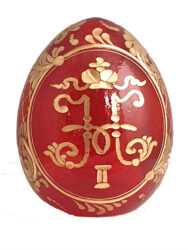10 Interesting Facts About Fabergé

A Fabergé egg is one of a predetermined number of jewelled eggs made by Peter Carl Fabergé and his organization somewhere between 1885 and 1917. After being dispatched to make an Easter egg for the illustrious group of Russia in 1885, the Imperials preferred the outcome such that further eggs were authorized every year.
Fabergé created one egg each year for Tsar Alexander and afterwards two every year after Nicholas II was delegated. Each egg required a year or more to make, including a group of profoundly talented experts who worked in the best mystery. Fabergé was given a finished opportunity in the plan and execution, with the solitary essential being that there must be shock inside every creation.
The eggs turned out to be progressively extravagant, and no cost was saved in their creation. For instance, the egg made in 1900, The Trans-Siberian Railway egg, was made of gold, silver, onyx and quartz, and its inside was fixed with velvet.
1. The First One Was Created For The Russian Royal Family
In the year 1885, the first Fabergé egg was created on the demand of the great Emperor Alexander III. He ordered Peter Carl Fabergér to design a stupendously luxurious Easter blessing to brighten up his young, nostalgic spouse, Empress Maria Feodorovna.
Originally he planned to design an egg that holds a diamond ring inside in the center. But something else came to mind, and he instructed that the finished egg should contain the ruby pendant. The egg had a murky white plated external shell which opened by bending the two parts of the egg to uncover the principal shock – a matt yellow gold yolk. Following that was a plated, pursued gold hen that held a copy of the Imperial Crown with a valuable ruby pendant egg. His young spouse was so dazzled by her lovely blessing that the Emperor kept on having them made every year.
2. Become Family Tradition
When Tsar Alexander III’s demise in the year 1894, his child Nicholas II completed the custom of gifting an egg to the two his better half and mother. You will be amazed to know that 50 eggs were made for the two Empresses somewhere in the range of 1885 and 1917. At this time Russian Revolution and the defeat of the royal family took place. The eggs regularly commended the Romanov family and Russian history. The egg that was designed in 1906 was incorporated into a scaled-down copy of the Moscow Kremlin and the Coronation egg to praise the crowning ordinance of Tsar Nicholas II in 1896 with an imitation of Catherine, the Great’s eighteenth-century illustrious mentor.
3. Eight Eggs Are Still Unidentified.
The Russin revolution started in the year 1917, and the Romanov family fell. At that time, the fifty Imperial Eggs were unfortunately plundered and spread all around the world. One of the missing eggs was most recently seen at Wartski in June 1952, where it was offered to a puzzling purchaser just named ‘A Stranger’ for £1250. It was the Imperial Fabergé Nécessaire Egg and created in 1889. It was dazzlingly set with jewels, emeralds and rubies, and was planned to hold magnificence devices.
4. One Was Found At A Street Market.
In the year 2014, an American salvaged material seller bought the golden egg at a swap meet for $13,300 (£8000), and he had no idea what he had found. When he neglected to sell it on the grounds that planned purchasers believed it to be over-evaluated, he chose to investigate the piece further. After doing research, he found that now he was indeed the proprietor of a tragically missing Imperial Egg worth £20 million. The egg presently has a place with a private authority.
This egg, known as the Third Imperial Egg, was presented to Empress Maria Feodorovna in 1887 for Easter. This yellow gold egg gets open by squeezing the splendid cut jewel to uncover a Vacheron Constantin watch with precious stone set gold hands that is pivoted. It is permitted to stand up. The egg is upheld on an intricate sabléd gold stand, remained on lion paw feet and encompassed by finely pursued hued gold wreaths.
5. All The Investments Tied Up In One Place
In 2004, tycoon Malcolm Forbes was set to sell his nine Fabergé eggs and 180 other Fabergé pieces at Christie’s. However, Russian oligarch Viktor Vekselberg dipped in to buy the whole assortment before the public deal. He purportedly spent $100 million for all the nine eggs.
Along with these nine eggs, Vekselberg obtained six other Fabergé eggs and opened the Fabergé Museum in St Petersburg in 2016. Now he has the collection of 15 Fabergé eggs: nine Imperial eggs, four Kelch eggs and four extra eggs.
6. The Ultimate Easter Egg Hunt
Total 50 eggs were crafted for the Russian Imperial family. And from which only 43 have been found, which means seven are as yet covered up. The photos of two of the eggs are available: the Royal Danish egg, which was made for Empress Feodorovna on the event of the 40th commemoration of the crowning ritual of her dad, and the Alexander III Commemorative egg for the fifteenth commemoration of the passing of Alexander III, the Emperor of Russia. The exact information of the remaining seven eggs is unknown.
7. Daring Capacity of the Artists
You will be amazed to know that the jewelers honed their skills not only in the classic sense, but they also dared to do daring experiments to design the faberge eggs. You can realize this by looking at the 1905 – Proletarian Breakfast. And a golden yolk broken egg on a jasper block covered with a piece of paper. The beauty of the Faberge eggs are eye-catching, and you will give pressure to your mind to calculate the time and effort required to design the egg. You will be amazed to know that the goldsmiths sharpened their abilities in the exemplary sense and set out to do challenging experiments to design the eggs.
9. From Faste To Ruin
When the Bolshevik revolution took place, the extravagance house, which was going through a troublesome period for clear reasons connected to constraint and migration, saw its character usurped by an American fragrance maker. In the year 1917, the luxury house vanished with 75 years of presence. Simultaneously, the Russian Emperor has been driven away from power.
10. The Brand Makes Its Come Back In Switzerland
In 2007, the French financial specialist and gem dealer craftsman Zaavy Frédéric managed the new imaginative line of the brand. He started taking care to resurrect the glory and the custom. With his effort, he successfully opened the main store in Switzerland in 2010. Furthermore, today, on account of the endeavours of the best associates, the name of Peter-Karl is back in style. Likewise extravagant, however more contemporary, she decreases her speciality in embellishing objects all made in gold, silver and surprisingly set with precious stones.
If you want to experience how these Faberge eggs look and feel, buy them from The Russian Treasures website. We have a good collection of these eggs.
